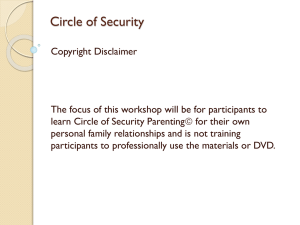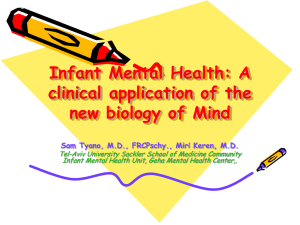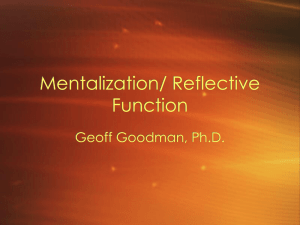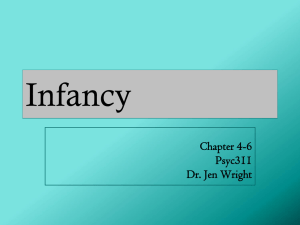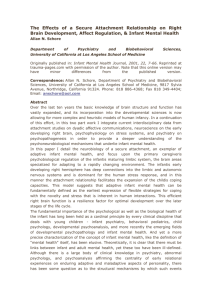Here - Mindful Policy Group
advertisement
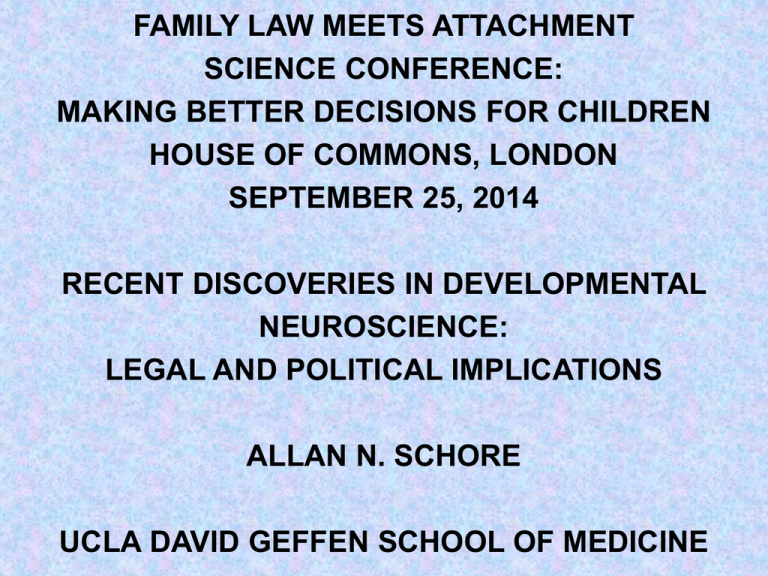
FAMILY LAW MEETS ATTACHMENT SCIENCE CONFERENCE: MAKING BETTER DECISIONS FOR CHILDREN HOUSE OF COMMONS, LONDON SEPTEMBER 25, 2014 RECENT DISCOVERIES IN DEVELOPMENTAL NEUROSCIENCE: LEGAL AND POLITICAL IMPLICATIONS ALLAN N. SCHORE UCLA DAVID GEFFEN SCHOOL OF MEDICINE • Leckman and March, Developmental neuroscience comes of age, J. Child Psychology and Psychiatry, 2011: Describe “the phenomenal progress of the past three decades in the developmental neurosciences.” • “Over the past decade it has…become abundantly clear that…the dyadic relations between child and caregivers within the first years of life can have direct and enduring effects on the child’s brain development and behavior.” • “The enduring impact of early maternal care and the role of epigenetic modifications of the genome during critical periods in early brain development in health and disease is likely to be one of the most important discoveries in all of science that have major implications for our field.” • Brain development not just genetically encoded; needs epigenetic social experiences. Not one or other but gene-environment interactions, mother nature and mother nurture combine to shape human nature. • Here briefly review my ongoing work in developmental neuroscience and attachment theory, then offer implications for family law and policy. • Schore (Affect Regulation and the Origin of the Self, 1994): interpersonal neurobiological model of attachment. Integrate early child development and brain development to emotional development. • J. Schore & A. Schore (Modern attachment theory: The central role of affect regulation in development and treatment, Clinical Social Work J., 2008): • “We suggest that in line with Bowlby’s fundamental goal of the integration of psychological and biological models of human development, the current clinical and experimental focus on how affective bodily-based processes are nonconsciously interactively regulated…has shifted attachment theory to a regulation theory.” • Schore (Science of the Art of Psychotherapy, 2012): • “Attachment theory, first created by…John Bowlby over 50 years ago, is now revitalized, particularly by its deep connections with neuroscience. At this point in time, we have in attachment theory a coherent theory of development that is grounded in both psychological science and neuroscience, and thereby is on a much firmer ground than it used to be.” • Schore (1994-2014): interpersonal neurobiological model of attachment mechanism; relational, socialemotional attachment experiences shape developing “social,” emotional” right brain and thereby emotional well-being in later stages of life. • Schore (Science of the Art of Psychotherapy, 2012): • “There is now agreement…that the essential task of the 1st year of human life is the co-creation of a secure attachment bond of emotional communication between the infant and his/her primary caregiver. • The baby communicates its burgeoning positive emotional states (e.g., joy, excitement) and negative emotional states (e.g., fear, anger) to the caregiver so that she can then regulate them. • The attachment relationship shapes the ability of the baby to communicate with not just the mother, but ultimately with other human beings.” • Bowlby (1969): mother-infant attachment communications are “accompanied by the strongest of feelings and emotions, and occur within a context of facial expression, posture, tone of voice…” • Bowlby (1991): “Emotion is nonverbal communication of basic but very powerful attitudes in mind and potential action.” • Schore (1994): in episodes of right brain-to-right brain visual-facial, auditory-prosodic, and tactilegestural emotional transactions, sensitive attuned primary caregiver is receptive to infant’s bodilybased nonverbal attachment communications. • Attachment emotional facial communications between infant’s right brain and mother’s right brain. • Infant: “The right hemisphere can be considered dominant in infancy, for the type of visual and acoustic communication which is relevant for the prelinguistic child.” (Brown and Jaffe, Neuropsychologia, 1975). • Adult: “The neural substrates of the perception of voices, faces, gestures, smells, and pheromones, as evidenced by modern neuroimaging techniques, are characterized by a general right-hemispheric functional asymmetry” (Brancucci et al., Proc. Royal Soc. London B, 2009). “Life began with waking up and loving my mother’s face” George Eliot • Mother not only receives infant’s right brain emotional communications, but then interactively regulates them. • Attachment = interactive regulation of emotion. • Baby becomes securely attached to psychobiologically attuned caregiver who minimizes negative affect (e.g., fear, in soothing) and maximizes positive affect (e.g.,joy, in play). • “It is the emotional availability of the caregiver in intimacy which seems to be the most central growthpromoting feature of the early rearing experience.” • Winnicott (1986): “The main thing is a communication between the baby and the mother in terms of the anatomy and physiology of live bodies.” • Ovtscharoff & Braun (Neuroscience, 2001): • “The regulatory function of the newborn-mother interaction may be an essential promoter to ensure the normal development and maintenance of synaptic connections during the establishment of functional brain circuits.” • Human brain growth spurt. Brain doubles size 1st year. • Lagercrantz & Ringstedt (2001): prenatal and postnatal periods rate of synaptogenesis estimated at 40,000 new synapses every second. • Schore (1996): “The self-organization of the developing brain occurs in the context of a relationship with another self, another brain.” • Schore (1994): infant’s early developing right brain circuits are shaped by attachment experiences. • Minagawa-Kawai (Cerebral Cortex, 2009): nearinfrared spectroscopy study of infant-mother attachment, “our results are in agreement with that of Schore (2000) who addressed the importance of the right hemisphere in the attachment system.” • Ratnarajah et al. (NeuroImage, 2013): [I]n early life the right cerebral hemisphere could be better able to process…emotion (Schore, 2000; Wada and Davis, 1977). …These neural substrates function as hubs in the right hemisphere for emotion processes and mother and child interaction.” • Schore (1994): subsequent to child’s attachment to mother in 1st year, forms another to father in 2nd • Herzog (2001): “The biorhythmicity of man with infant and woman with infant” affords infant to have “interactive, state-sharing, and state-attuning experiences with two different kinds of caregivers.” • Schore (2003): father later critically involved in male and female toddler’s aggression regulation [vs. earlier mother and fear regulation] • Braun’s laboratory in Germany (2006): paternal care affects synapse formation of the developing brain. • Abraham et al., Father’s brain is sensitive to child care experiences. PNAS USA, 2014. • Study parental brain response to infant stimuli using fMRI. Measure “primary caregiving” mothers and “secondary caregiving fathers.” Mean age of infants – 11 months. • Describe a “parenting caregiving” expressed in two different brain systems: “subcortical-paralimbic structures implicated in emotional processing and cortical areas involved in social understanding. Mothers showed greater activation in the emotional processing network and fathers in the social cognitive circuits.” • Schore (1994): attachment source of right brain functions of emotional well-being over life span. • Sullivan & Dufresne (2006): “right hemispheric specialization in regulating stress - and emotionrelated processes.” • Decety & Chaminade (2003): “Mental states that are in essence private to the self may be shared between individuals... self-awareness, empathy, identification with others, and more generally intersubjective processes, are largely dependent upon...right hemisphere resources, which are the first to develop.” • Schutz (2005): “The right hemisphere operates a distributed network for rapid responding to danger and other urgent problems. It preferentially processes environmental challenge, stress and pain and manages self-protective responses such as avoidance and escape.” • Hecht (2014): “[T]he right hemisphere has a relative advantage over the left hemisphere mediating social intelligence – identifying social stimuli, understanding the intentions of other people, awareness of the dynamics in social relationships, and successful handling of social interactions.” • Schore (2012) models of psychopathogenesis: “Essentially, interpersonal neurobiology explains how early social-emotional experience indelibly influences later experience—by impacting and altering the developing brain…The emotional relational environment provided by the primary caregiver shapes, for better or worse, the experience-dependent maturation of the brain systems involved in attachment functions that are accessed throughout the life span.” • Best current description of path of infant brain development is that it is “malleable” (not “resilient”). • Knickmeyer et al. (J. Neuroscience, 2008): “The large increase in total brain volume in the first year of life suggests that this is a critical period in which disruption of developmental processes, as the result of innate genetic abnormalities or as a consequence of environmental insults, may have long-lasting or permanent effects on brain structure and function…the first year of life may be a period of developmental vulnerability…” • Infants-toddlers have unique social emotional needs that are dependent on attachment. Critical role in later right brain emotional well-being. • Implications of modern attachment theory and developmental neuroscience for family law • Schore & McIntosh. (2011). Family law and the neuroscience of attachment, Family Court Review. • Interpersonal neurobiological perspective of modern attachment theory used to address family law decision about divorce in the first year directed towards “the best interest of the child.” • Pruett, McIntosh, & Kelly. (2014). Parental separation and overnight care of young children: Consensus through theoretical and empirical integration: Part l. Family Court Review. • Describe “broad eras within the first 3 years; “the first 18 months of life, the second eighteen months of life (18-36 months), and year of being three” (3-4) • Work of developmental neuroscience described previously primarily on the first year and earlier: prenatal, perinatal and postnatal periods of infancy. • Emotional communications of primary attachment relationship indelibly impact infant brain development during human brain growth spurt from last trimester pregnancy through 18-24 months. • Key point: The rapidly developing brain of an infant is quantitatively and qualitatively different from not only adults but 3-4 year old children. • 0-18 months, period of attachment, also critical period of right brain maturation. • Schore (1994): mother-infant right brain-to-right brain attachment experiences shape maturation of infant’s developing right brain. • Howard & Reggia (Brain and Cognition, 2007): “Earlier maturation of the right hemisphere is supported by both anatomical and imaging evidence.” • Chiron et al. (Brain, 1997): “The right brain hemisphere is dominant in human infants.” • Allman et al. (Trends in Cognitive Sciences, 2005): “The strong and consistent predominance for the right hemisphere emerges postnatally.” • Enormous body of research over numerous scientific and clinical disciplines (pediatrics, child psychiatry, developmental psychology etc.) also highlights centrality of mother-infant relationship to later social-emotional functions. • Both attachment researchers and clinicians, as well as neuroscience uses the term “primary caregiver,” equating term with mother. • Key point: separation from primary attachment object, mother in first year is qualitatively different from separation at 3-4, and from separation with father in first year. Research show long-term neurobiological effects of separation are profound. • Parallel studies in developmental neuroscience indicate critical role of mother on infant brain development. Only handful of studies on father, who impacts different, later forming areas than mother. • Separations from mother and father in first year not equivalent in terms of impact on social/emotional development. Essential communications - mother’s right brain and infant’s developing right brain. • Key point: Developmental neuroscience can offer “evidence-based” information on infant separation in overnight care policy. Modern attachment theory offers pragmatic model of both neurobiological and psychological “best interest of the infant.” • Few studies on specifically overnight separations in infancy vs. 3-4 years. • Solomon and George (1999): 12 and 30 months, regular overnight arrangements, one night per week. Report greater propensity for anxious, unsettled behavior on reunion with primary caregiver in regular overnight group of infants, and a greater propensity for the development of insecure and disorganized attachment with the caregiver by age 30 months. • Tornello et al. (2013): 1 vs. 3 year olds. More frequent overnights were significantly associated with attachment insecurity among infants. • Most relevant current research on overnights integrates modern attachment theory and developmental neuroscience. • McIntosh et al, Overnight care patterns following parental separation: Associations with emotion regulation in infants and young children. Journal of Family Studies, 2013. • Studies 0-1, 2-3, and 4-5 year old groups. • “Developmental studies have linked prolonged and/or frequent separation from primary caregiver with increased potential for emotional disorganization.” • In addition to psychological studies “the field of interpersonal neurobiology suggests a neurodevelopmental vulnerability of infants in the first year of life to prolonged separation and unpredictable care.” • Findings: “Greater number of shared overnight stays for the 0-1 year old and 2-3 year old groups predicted less settled and poorly regulated behaviours, but none for the 4-5 year old group.” • Body of evidence now suggests a “dys-regulating influence for the infant of repeated, lengthy or unpredictable absence from a primary-caregiver, despite being in the after care of others.” • Divorce in first year is both a significant psychological and biological stressor to all infants • Now well established that stress, especially interpersonal stress between mother and infant impacts specifically right brain growth in critical periods of first year, with long term consequences on emotion and social development over life span. • Overnight care patterns, which include separations from primary caregiver are an attachment stressor for infants that negatively impacts the developing right brain, which for rest of lifespan is dominant for processing stress. • Schore & McIntosh (2011): “Any type of human behavior which opposes the way that wellregulated biological systems optimally function should be viewed as interfering with and not promoting the psychological and biological development of the infant.” • Conclusion: recent developmental neuroscience on the right brain and attachment now suggests negative impact of shared-time parenting arrangement following separation and parental overnights in first (and second) year, when brain doubles in size. Family Law policy about infants needs to incorporate this recent knowledge. • Broader cultural and political implications: • Schore, Infant Mental Health Journal, 2001: • “The earliest stages of humanhood are critical because they contain within them the representation of our possible futures – they model the potential developmental extension of our individual and collective identities…When and where shall we place our current resources so as to optimize the future of human societies?...How much should we value the very beginnings of human life, in tangible social program dollars.” • UNICEF report, “Child Well-Being in Rich Countries, 2013: (UK 16/29; 2007 21/21; US 26/29) • “It is perhaps no longer necessary to argue the case for the importance of the early years. Advances in both neuroscience and social science have repeatedly confirmed that it is at this time that genetic potential interacts in infinitely complex ways with early experience to construct the neural pathways and connections that quickly become both the foundations and the scaffolding for all later development.” • “It is therefore at this time that the child’s wellbeing, health and development are most in need of society’s concern and protection.” • Science weighs in: Archives of Diseases of Childhood, 2014, “Disproportionate disadvantage of the young: Britain, the UNICEF report on child well-being, and political choices,” I. Wolfe. • “We are at a pivotal moment in UK child health, when recent gains are likely to be lost. The Unicef report strikes right to the heart of a defining question for our times: what is the duty of the State in protecting and providing the best conditions for nurturing our children? Government policy can foster or hinder children’s health, development and wellbeing.” • Science, July 20, 2014: Editorial, “A focus on child development,” K.L. Silver & P.A. Singer (Canada). • Speak to role of the policy goals of the United Nations. • “Investing in child development is the foundation for improved health, economic, and social outcomes. Not getting the early years ‘right’ is linked to violent behavior, depression, higher rates of noncommunicable disease, and lower wages, and it negatively affects a nation’s gross domestic product.” • Emphasis on child development “would put the focus where it belongs: on the end beneficiary, the child, and her or his potential for development.” • Refer to “the fundamental importance of early child development to overall sustainable development.” • “Recent advances in neuroscience indicate the importance of healthy brain development in the early years to human capital formation…A society only reaps the full benefits of a child’s survival if that child becomes a productive individual as an adult.” • “An increase in thriving children over the next 15 years would lay a stronger foundation for healthy, prosperous, and peaceful societies.” • “Healthy brain development” = enduring effects of optimal right brain development, secure attachment, and relational origins of emotional well-being.


